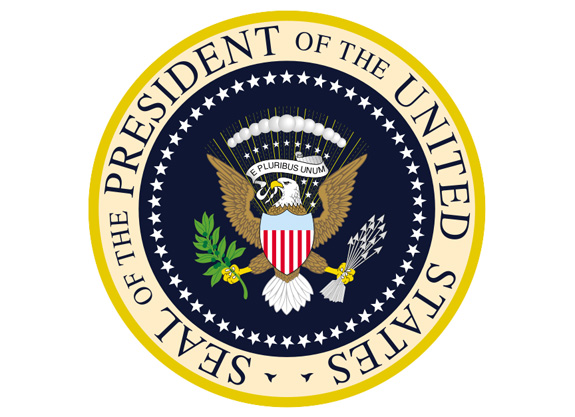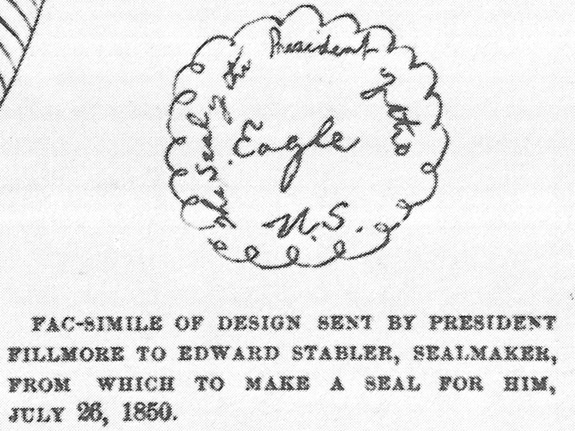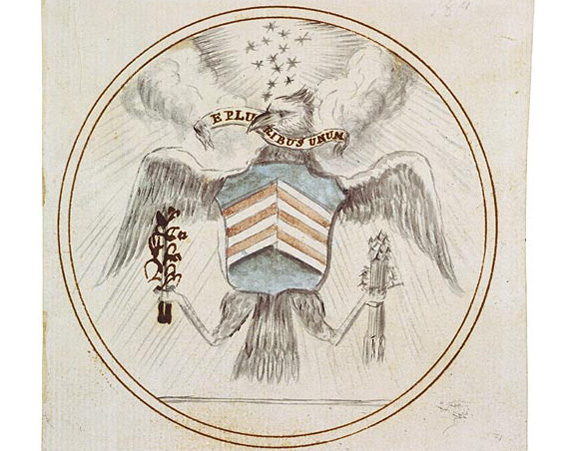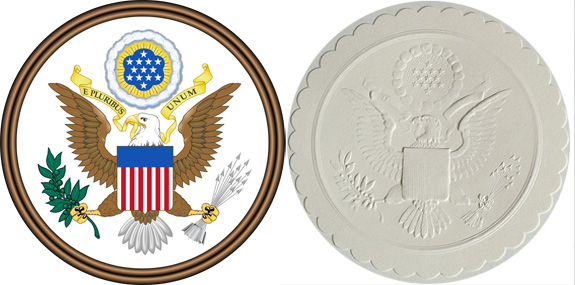Who Designed the Seal of the President of the United States?
We see it on the President’s lectern and in the Oval Office, but who came up with the look and feel of it in the first place?
![]()

A scaled and dimensioned drawing of the Presidential Seal, as attached to Executive Order 10823 (image: Wikimedia Commons)
During President Obama’s inauguration on the Capitol steps, he stood behind a lectern, as he always does when speaking in public, adorned with the Seal of the President of the United States. Later that evening, after the ceremonies and parades, he danced across the symbol with the First Lady. It’s on the floor of the Oval Office and on stamped on the Presidential Physical Fitness Award certificate (or so I’m told). The Presidential Seal is one of the most recognizable symbols in the world and one of the few examples of American heraldry, but who designed it?

The modern seal of the President of the United States (image: whitehouse.gov)
According to the Encyclopedia of the American Presidency, the modern seal was first defined on October 25, 1945, by President Harry Truman in Executive Order 9646. It depicts an Eagle holding 13 arrows in one talon and an olive branch with 13 leaves in the other, surrounded by a ring of 50 stars (Executive Order 10860 added stars for Alaska and Hawaii in 1960) and the words “Seal of the President of the United States.” The words make it official. Otherwise, it’s considered the Presidential Coat-of-Arms; without the stars, it’s basically just the Great Seal of the United States, after which the Presidential Seal is modeled. The seal existed in various iterations before Truman –several can be seen embedded in the architecture and furnishings of the White House–but the 33rd President made a critical alteration to the design: he changed the direction the eagle faced. No longer was the symbolic representation of the United States looking toward the arrows or war, but to the olive branch of peace. Significantly, at the same time, the Department of Defense officially replaced the Department of War. According to Truman biographer David McCullough, the changes were intended to be seen as a symbolic of an nation both on the march yet still dedicated to peace.
But let’s go back further. The earliest documented Presidential Seal was conceived by President Millard Fillmore in an 1850 sketch that he then sent to Edward Stabler, a nationally renown seal engraver. To say that Fillmore designed the seal would be a stretch – even to call his conception a “sketch” seems a bit generous.

President Millard Fillmore’s 1850 sketch of the Presidential Seal (image: The Eagle And The Shield via Wikimedia Commons)
The heavy lifting was definitely done by Stabler. Born in Maryland in 1794, Edward Stabler was self-taught and began his career engraving jewelry at the age of 16. By the time he retired in 1863, Stabler had designed seals for nearly every department in the Federal Government, several states, cities, and many businesses.
Stabler’s design appropriates the coat-of-arms first used on the obverse side of the Great Seal of the United States – whether or not that’s what Fillmore intended to communicate with his “eagle” sketch, we’ll never know. The Great Seal that inspired Stabler was first commissioned by a committee of our designer forefathers –Ben Franklin, Thomas Jefferson, and John Adams– during the Continental Congress on July 4, 1776. However, it wasn’t formally adopted by Congress until 1782 – after a war, two more design committees, and many redesigns. Perhaps realizing after six years that a design by committee isn’t exactly the most efficient process, all the sketches, notes, and suggestions were entrusted to Charles Thompson, Secretary to the Continental Congress, who consolidated the various materials into a final design, which proved a success. So the modern Presidential Seal can be traced back to the coat-of-arms first created by Charles Thompson in 1782 for the Great Seal of the newly independent United States of America.

Charles Thompson’s 1782 design for the Great Seal (image: National Archives)
Thompson’s design has stood the test of time, and though the eagle has been considerably bulked up in the intervening years, it closely resembles the modern Great Seal. When Thompson submitted the seal to Congress, he included what is still the only official explanation of its symbolism.
“The Escutcheon is composed of the chief & pale , the two most honorable ordinaries .The Pieces, paly , represent the several states all joined in one solid compact entire, supporting a Chief, which unites the whole & represents Congress.The Motto alludes to this union. The pales in the arms are kept closely united by the Chief and the Chief depends on that union & the strength resulting from it for its support, to denote the Confederacy of the United States of America & the preservation of their union through Congress.
The colours of the pales are those used in the flag of the United States of America; White signifies purity and innocence, Red, hardiness & valour, and Blue, the colour of the Chief signifies vigilance, perseverance & justice.The Olive branch and arrows denote the power of peace & war which is exclusively vested in Congress.The Constellation denotes a new State taking its place and rank among other sovereign powers. The Escutcheon is born on the breast of an American Eagle without any other supporters to denote that the United States of America ought to rely on their own Virtue.”
Although the Great Seal is most often used as a graphic image, it is of course still a seal. In the Department of State the term “Great Seal” technically includes the entire sealing apparatus: die, counter-die, press, and mahogany housing.

The Great Seal of the United States and an impression of the seal (right image: Alex Jamieson via Wikimedia Commons)
It is used with the authority of the Secretary of State to authentic documents issued by the Federal Government but it’s also used by the President when he signs documents as the representative of the United States. The Presidential Seal –distinguished by its ring of stars and text– has a much more limited use that the Great Seal. There is only one brass die in the White House –technically, speaking the only true Seal of the President of the United States– and it is reserved for the President’s personal correspondence to Congress. The official seal is probably as closely guarded as the official autopen, but the Bureau of Engraving has other seals that are used for creating sanctioned facsimiles. As for the graphic image of the seal, commercial use is prohibited, with the only exception being official fundraisers, and all use of the seal is strictly regulated to maintain the dignity of the office. For me, however, it will always be a reminder of my own lost dignity and the pull-ups I could never do to get that Presidential Physical Fitness Award in elementary school.
/https://tf-cmsv2-smithsonianmag-media.s3.amazonaws.com/accounts/headshot/Jimmy-Stamp-240.jpg)
/https://tf-cmsv2-smithsonianmag-media.s3.amazonaws.com/accounts/headshot/Jimmy-Stamp-240.jpg)